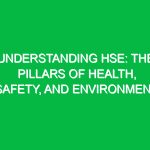Introduction to Health Hazard Symbols
In the dynamic landscape of workplace safety, health hazard symbols serve as crucial indicators that communicate potential risks associated with various substances and processes. These symbols are an integral part of the Health, Safety, and Environment (HSE) framework, designed to safeguard individuals from harm. The health hazard symbol specifically identifies chemicals or situations that pose health risks, such as irritation, sensitization, carcinogenicity, and toxicity. Understanding these symbols not only enhances safety practices but also fosters a culture of awareness and preparedness among workers.
Imagine walking into a laboratory, where various chemicals are stored. Each container bears a label adorned with a health hazard symbol, instantly conveying critical information. For instance, a symbol depicting a skull and crossbones warns of acute toxicity, alerting individuals to handle the substance with extreme caution. Such visual cues are not merely decorative; they are essential tools in promoting safety and preventing accidents.
The Importance of Health Hazard Symbols in HSE
The relevance of health hazard symbols in HSE cannot be overstated. These symbols play a pivotal role in risk communication, providing essential information about the nature of hazards present. By understanding the meaning behind these symbols, employees can take appropriate precautions, reducing the likelihood of accidents and occupational illnesses.
In workplaces where chemicals are prevalent, such as manufacturing plants, laboratories, and construction sites, health hazard symbols become critical. They empower workers to recognize and respond to hazards effectively. Moreover, they contribute to compliance with regulatory standards, ensuring that organizations adhere to safety protocols and legal requirements.
Identifying Health Hazards Associated with Health Hazard Symbols
Understanding health hazard symbols requires a closer examination of the risks they represent. Each symbol corresponds to a specific health hazard:
1. Toxicity
The health hazard symbol indicating toxicity features a skull and crossbones. It signifies substances that can cause severe harm or death if inhaled, ingested, or absorbed through the skin. For instance, certain pesticides may carry this symbol due to their potent effects on human health.
2. Irritation
The exclamation mark symbol indicates substances that can cause skin or eye irritation. Workers exposed to irritants may experience redness, itching, or discomfort. For example, certain cleaning agents or solvents can trigger such reactions, necessitating protective measures like gloves and goggles.
3. Sensitization
The health hazard symbol for sensitization shows a hand with a heart symbol, indicating that a substance may cause allergic reactions upon repeated exposure. This is commonly found in certain chemicals used in paints or adhesives, where prolonged contact can lead to skin sensitization.
4. Carcinogenicity
The cancer symbol, often represented by a stylized silhouette of a person with a cancer ribbon, warns of substances that may lead to cancer after prolonged exposure. Asbestos is a notorious example, highlighting the importance of recognizing this hazard in construction and demolition activities.
5. Reproductive Toxicity
The reproductive hazard symbol, typically depicted as a fetus or a pregnant woman, alerts workers to substances that may adversely affect reproductive health. Chemicals like lead and certain solvents fall into this category, emphasizing the need for special precautions among workers in relevant industries.
Safety Precautions for Health Hazards
Recognizing health hazard symbols is merely the first step; implementing safety precautions is vital in minimizing risks. Here are some best practices:
1. Proper Labeling and Signage
Ensure that all containers are clearly labeled with appropriate health hazard symbols. This not only aids in identification but also reinforces the importance of safe handling. Regularly review and update labels as necessary.
2. Personal Protective Equipment (PPE)
Encourage the use of PPE tailored to the specific hazards present. For instance, gloves, goggles, and masks should be provided and required when handling toxic or irritating substances. Training employees on the correct usage of PPE is equally important.
3. Training and Awareness
Conduct regular training sessions to familiarize employees with health hazard symbols and their meanings. Case studies showcasing real-life incidents can enhance understanding and highlight the importance of vigilance.
4. Safety Data Sheets (SDS)
Ensure that Safety Data Sheets are accessible for all chemicals used in the workplace. These documents provide comprehensive information about hazards, handling instructions, and emergency procedures, serving as a vital resource for employees.
5. Emergency Procedures
Establish clear emergency procedures for incidents involving hazardous substances. Regular drills can prepare employees to respond effectively to spills, exposure incidents, or other emergencies.
Regulations and Standards Governing Health Hazard Symbols
Health hazard symbols are not arbitrary; they are governed by a plethora of regulations designed to protect workers. In the United States, the Occupational Safety and Health Administration (OSHA) plays a pivotal role in establishing standards for hazardous materials. The Globally Harmonized System of Classification and Labelling of Chemicals (GHS) further standardizes hazard communication, ensuring consistency across industries.
In the European Union, the Classification, Labelling, and Packaging (CLP) Regulation aligns with GHS principles, mandating that hazardous substances are clearly labeled with appropriate symbols. These regulations aim to create a safer work environment by ensuring that employees are informed of the risks associated with their tasks.
Conclusion: The Path Forward
Understanding health hazard symbols is an essential component of fostering a safe and compliant workplace. By recognizing the risks associated with these symbols and implementing appropriate safety measures, organizations can protect their most valuable asset: their employees.
Personal anecdotes from safety professionals highlight the profound impact of education and awareness in mitigating risks. One safety manager shared how a simple training session on health hazard symbols led to a significant decrease in incidents involving chemical exposure at their facility. This emphasizes the need for ongoing education and commitment to safety practices.
As we move forward, it is imperative to cultivate a culture of safety that prioritizes awareness, training, and adherence to regulatory standards. Health hazard symbols are more than mere icons; they are vital tools that empower individuals to take charge of their safety and well-being in the workplace. Through vigilance and responsibility, we can create safer environments for all.


